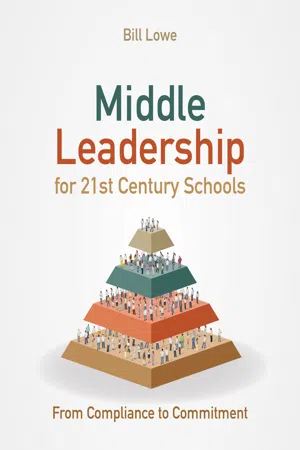
- 168 pages
- English
- ePUB (mobile friendly)
- Available on iOS & Android
About This Book
p>In Middle Leadership for 21st Century Schools: From compliance to commitment, Bill Lowe sets out for middle leaders the essential elements of a contemporary leadership approach that will help them successfully navigate a rapidly changing educational landscape.
The position of middle leader is one of the most challenging in any workplace. But knowing how to lead a team effectively will ensure that you, as a middle leader, have the greatest possible impact both on your team and on school improvement.
In Middle Leadership for 21st Century Schools, Bill expertly combines the latest educational leadership research with anecdotal reports about a wide range of real-life school experiences, giving you the insights to help you establish yourself and strengthen your influence in the role. He shares impactful advice on boosting productivity both your own and your team's and offers guidance on how to succeed through people-focused leadership, rather than by using data as a weapon.
Covering a range of issues from dealing with conflict and difficult conversations to building and maintaining your professional image this book reveals the how of leadership when applied to the day-to-day demands of the school setting.
Well-established leadership and management ideas are identified, alongside a wealth of powerful strategies that work in the modern education world but this book also goes beyond that. Importantly, it uses your own experiences of being a leader and being led to illustrate key points so that the theories can be seen in practice.
Furthermore, the act of reflecting on practice and experience is built into this book, providing honest reflection and current experience reflection activities that invite you to consider things that you have seen, been subjected to and experienced first-hand during your time in education. You will also have opportunities to think about how you might have done things differently and how you will approach things in the future.
Suitable for both established and aspiring middle leaders in primary and secondary schools.
Frequently asked questions
Information
Leadership and Management: Some Definitions
The differences between leadership and management


| Current experience reflection activity | |
| Examples of why | |
| I am a more natural leader. | |
| I am a more natural manager. | |
What do they look like?
Leadership fundamentals



Table of contents
- Cover
- Praise
- Title Page
- Preface
- Acknowledgements
- Contents
- Introduction
- Chapter 1: Leadership and Management: Some Definitions
- Chapter 2: Leadership Dispositions: How Successful Leaders Behave
- Chapter 3: Building Your Professional Image: Looking Like a Leader
- Chapter 4: Leading Your Team: The Essence of Middle Leadership
- Chapter 5: Leading Change: Where Your Leadership Ability Is Judged
- Chapter 6: System Leadership from the Middle: A 21st Century Development
- Chapter 7: Dealing with Conflict and Difficult Conversations: Overcoming Awkward Situations
- Chapter 8: Productivity: At the Heart of Leader-Teacher Workload
- Chapter 9: The Next Steps: What to Consider When Moving Up the Ladder
- Closing Comments
- References
- Copyright
- Advertisement